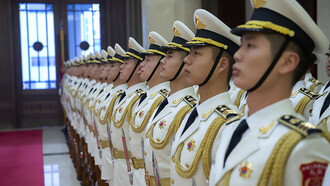Is it normal or reasonable to talk about visions and perspectives of peace in the Middle East while the sounds of explosions crack across the region and the remains of victims are scattered in every direction? I imagine that's not a tinge of insanity, but it is the responsibility of all peace advocates, and I do not exaggerate if I say that this is their destiny and their historical role in putting forward concepts and assumptions that take everyone out of the circle of violence and killing.
The scene does not evoke a measure of satisfaction, and what is more serious is that the circle is widening every day, and the clashes and threats are taking further and deeper paths, drawing the contours of a frightening scene that may burn everyone. It is even more ironic that this year marks the 25th anniversary of the adoption by the United Nations General Assembly of the Declaration and Program of Action on a Culture of Peace.
This declaration does not mean the absence of conflicts, but it requires a positive, dynamic, participatory process in which dialogue is encouraged and conflicts are resolved in a spirit of mutual understanding and cooperation. As a peace advocate, I am driven by responsibility and humanity to search for a light to guide us to the end of the dark tunnel.
In a world of rising geopolitical tensions and protracted conflicts, the UN General Assembly has articulated the values necessary for a culture of peace, which include respect for life, human rights and fundamental freedoms; the promotion of non-violence through education, dialogue and cooperation; commitment to the peaceful resolution of conflicts; and adherence to freedom, justice, democracy, tolerance, solidarity, cooperation, pluralism, cultural diversity, dialogue, and understanding at all levels of society and among nations. This seems to be a very important and influential endeavour, lacking visions and perceptions as well as a plan of action on the ground.
The deterioration of global peace
Many feel that the deterioration of global peace has become a pressing issue that has received considerable attention in academic and political circles in recent years. As conflicts persist and new threats to global stability emerge, it has become increasingly clear that the current international order is under pressure with the rise of authoritarian regimes adopting nationalist and protectionist policies that prioritise their own interests over those of the international community, leading to increased tensions and conflicts on the global stage.
In addition, the proliferation of nuclear weapons and other advanced military technologies has increased the stakes in international conflicts, making the possibility of large-scale war more likely than ever. The lack of effective conflict resolution and disarmament mechanisms further exacerbates this issue, leaving the world vulnerable to the devastating consequences of armed conflict.
The erosion of international institutions and norms, such as the United Nations and the Geneva Conventions, has weakened the collective capacity of the international community to address conflicts and support peace. The growing disregard for human rights and international law by some states further undermines the foundations of global peace and security.
In light of these challenges, it is imperative that policymakers, scholars, and civil society work together to strengthen the foundations of global peace. This requires a renewed commitment to multilateralism, diplomacy and conflict prevention, as well as recognising the interconnected nature of global challenges. We must also not forget that one of the main challenges in achieving lasting peace in the Middle East lies in the complex web of political, social, and historical factors that contribute to the persistence of conflicts in the region.
These multifaceted issues require a comprehensive and multidisciplinary approach in order to address the root causes of conflicts and facilitate sustainable peace-building efforts. An in-depth analysis of structural inequalities and their underlying power dynamics is necessary to develop effective strategies for conflict resolution and peace-building in the Middle East.
A nuanced understanding of the historical grievances, social and political complexities, and power imbalances that shape the conflict landscape in the region opens up endless possibilities for resolution. A comprehensive examination of the role of external actors and their interests in the region is critical to developing comprehensive and lasting peace agreements that take into account the various stakeholders involved in the Middle East conflicts as necessary to find lasting solutions capable of effectively managing the complex dynamics in the region.
The Global Peace Index (GPI) for 2024, published by the Institute for Economics and Peace (IEP), provides a comprehensive analysis of the state of peace around the world. The report reveals several important findings that highlight the ongoing challenges to global peace and security. One of the most important findings of the 2024 Global Peace Index is that the level of global peace continues to decline.
The average level of peace in countries deteriorated by 0.56 percent over the past year, the fifth consecutive year of decline. This trend is alarming, as it indicates a continued deterioration in the conditions that promote peace and stability around the world. The report notes that this decline is part of a broader trend, with peace declining year on year for 12 of the past 16 years.
Growing challenges
The report highlights the stark contrast in countries' performance in terms of their peacefulness. Last year, 65 countries saw their peacefulness scores improve, while 97 countries saw their scores deteriorate. This represents the highest number of countries that have deteriorated in a single year since the index began. The results suggest that while some countries are making strides toward peace, the vast majority face increasing challenges related to violence and conflict.
Indicators improve in Asia-Pacific
Despite being the second most peaceful region globally, the Asia-Pacific region recorded a slight deterioration in its overall peace score, which fell by 0.1 percent. This decline is attributed to a 2.4 percent deterioration in militarisation and a 1.6 percent increase in ongoing conflicts. However, safety and security improved, particularly in indicators related to violent demonstrations and homicide rates. Overall, 11 out of 19 countries in the region registered a deterioration in the indicators, while only eight countries improved.
Declining militarisation
The GGI 2024 report provides a detailed analysis of changes in various areas of peace. The safety and security domain showed a slight improvement, indicating progress in areas such as reducing violent demonstrations and improving homicide rates. In contrast, both the ongoing conflict and militarisation domains saw significant deterioration. The militarisation domain in particular saw a notable decline, reflecting increased military expenditures and the proliferation of weapons in various regions.
Structural imbalance
The report emphasises that the world is far less peaceful now than it was in 2008, with the average level of peace in countries deteriorating by 4.5 percent over this 16-year period. During this period, 95 countries became less peaceful, while only 66 countries improved. This long-term trend emphasises the systemic issues that contribute to violence and conflict, suggesting that the challenges to peace are not only immediate, but also deeply rooted in historical and structural factors.
Targeted interventions
Another important finding is the widening peace gap between the most peaceful and least peaceful countries. The report notes that the peace inequality gap has increased significantly since 2013. While the 25 most peaceful countries in 2024 were approximately 1 percent more peaceful than they were in 2008, the 25 least peaceful countries were 7.5 percent less peaceful than their counterparts in the first year of the index. This growing disparity highlights the need for targeted interventions to address the root causes of violence in less peaceful countries.
The most affected regions
The findings of the 2024 Global Peace Index have important implications for policymakers, civil society, and international organisations. The continued decline in global peace calls for renewed efforts to address the underlying factors of violence and conflict. This includes encouraging dialogue, strengthening conflict resolution mechanisms, and investing in social and economic development initiatives that promote peace. In addition, the widening inequality gap in peace requires a focus on the most affected regions and countries, ensuring that peace-building efforts are inclusive and equitable.
Insights gleaned
In short, the Global Peace Index 2024 presents a sobering picture of the state of peace around the world. The continued deterioration in the state of peace, the uneven performance of countries, and the widening peace inequality gap all point to the urgent need for concerted efforts to promote peace and security.
While the world faces complex challenges, the insights from the Global Peace Index serve as a critical reminder of the importance of promoting a culture of peace and addressing the root causes of conflict. The findings emphasize the need for collaborative action to build a more peaceful and just world for all.















